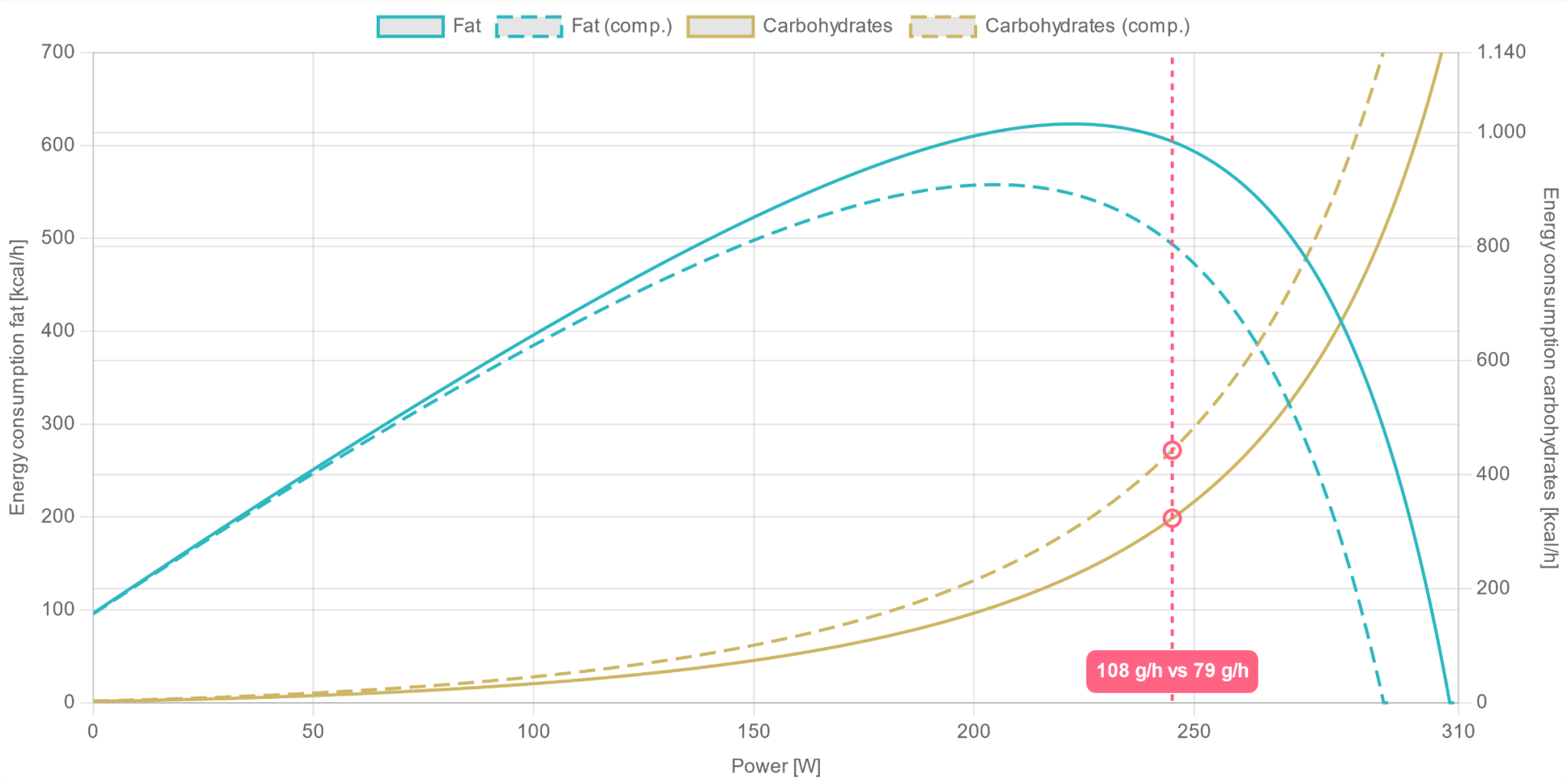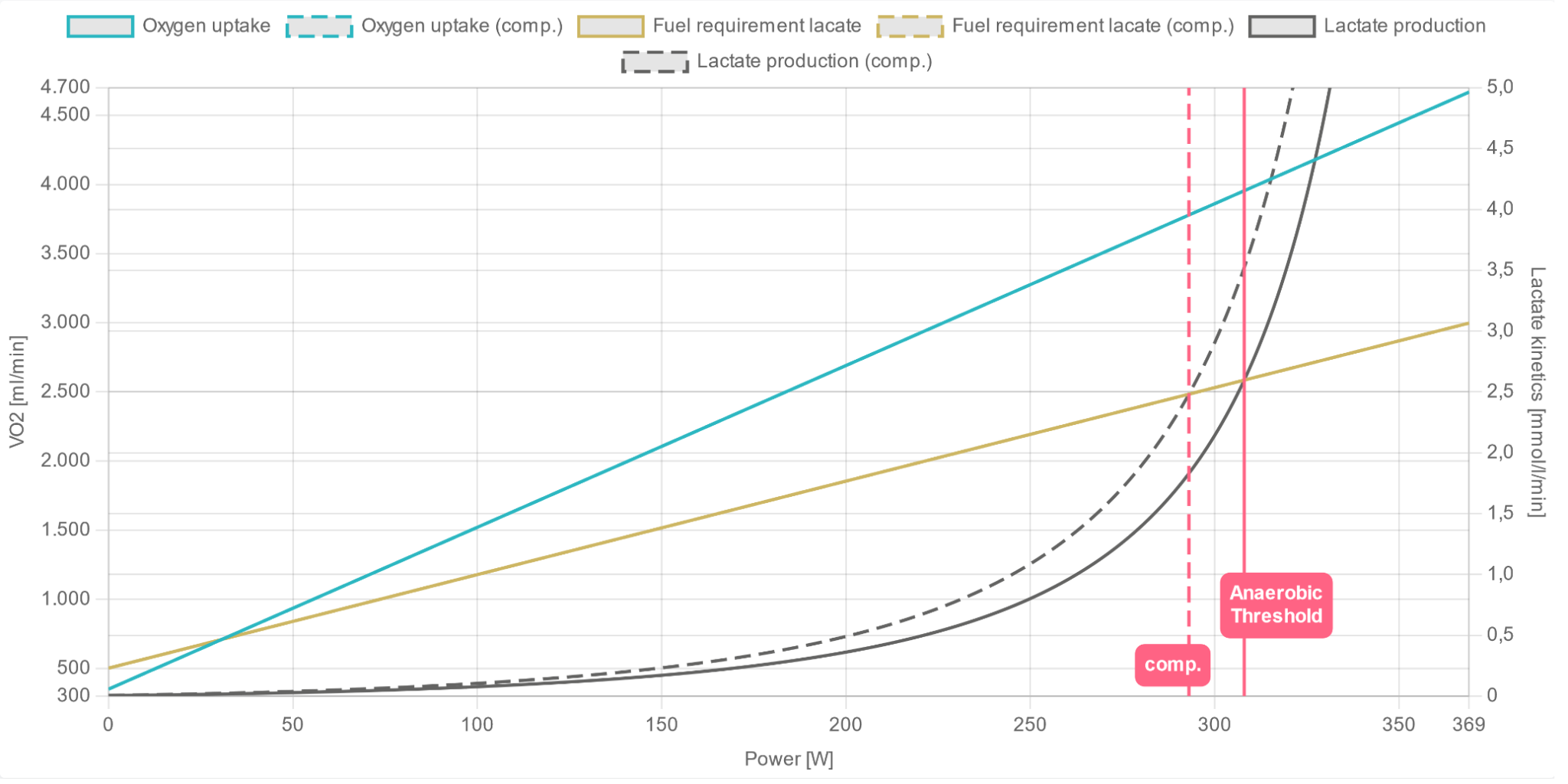The Maximal Lactate Production Rate – VLamax
In contrast to the maximal oxygen uptake (VO2max) as a metric for aerobic energy production and performance, the maximal lactate production rate (VLamax) describes anaerobic performance. As the term implies, VLamax represents the maximum rate at which lactate can be produced in the muscles (in mmol/l/s). Since lactate production is proportional to glycolytic energy supply, VLamax is an important parameter to understand endurance performance. Glycolytic activity and lactate production depend on several factors and can be decreased and increased by training. An easy-to-perform performance diagnostic from AI DIAGNOSTICS, allows cyclists and triathletes to determine their VLamax.
Relationship of VLamax and Glycolytic Performance
With rising intensity in training or competition, energy is increasingly provided by the anaerobic metabolism. In this process, known as glycolysis, glucose is broken down and lactate is produced. The energy released in this process is significantly less than in aerobic energy production, but much faster. Thus, glycolysis is of great importance for short, high-intensity exercise where the energy flux is high. The more energy is provided via the anaerobic metabolism, the more lactate is produced. Since the energy produced is proportional to lactate production, VLamax is a viable parameter to describe glycolytic performance.
↓ VLamax = ↓ Carbohydrates metabolized = ↓ Lactate production = ↓ glycolytic capacity
↑ VLamax = ↑ Carbohydrates metabolized = ↑ Lactate production = ↑ glycolytic capacity
Energy and Carbohydrate Expenditure
The lactate production rate is proportional to the energy production of glycolysis (carbohydrate metabolism). Therefore, VLamax serves as a parameter to determine individual carbohydrate consumption during exercise as only carbohydrates are metabolized in glycolysis. Since the body can only store limited amounts of carbohydrates in the form of glycogen, it is a major advantage in cycling and triathlon to know one's own energy and carbohydrate expenditure.
AI DIAGNOSTICS determines carbohydrate and fat combustion during exercise. The following graph is part of the AI DIAGNOSTICS performance report and describes the exponential increase of carbohydrate expenditure with increasing intensity. In the example shown, an improvement in VLamax (while VO2max remains the same) from 0.44 mmol/l/s to 0.33 mmol/l/s results in a decrease in carbohydrate consumption at 245 watts from 108 g/h to 79 g/h.

Energy comparison diagram of the two exemplary AI DIAGNOSTICS performance reports
How is the VLamax measured?
AI DIAGNOSTICS is a remote performance diagnostic method that allows you to determine VLamax from home via an easy-to-perform test protocol. It thus replaces a lactate test in the lab with a simple and valid self-test.
VLamax is an important parameter for athletes and coaches in endurance sports. It helps athletes to understand their individual physiology and to develop tailored training strategies to improve performance.
Another, but more complex way to determine VLamax is by means of a performance diagnostic in a HYCYS laboratory which determines the maximum lactate production rate on the basis of the measured lactate concentration (lactate test) in the blood.

Measuring the blood lactate concentration to determine the VLamax
How Does AI DIAGNOSTICS Determines the Maximal Lactate Production Rate?
AI DIAGNOSTICS users benefit from many years of experience in performance diagnostic labs and state-of-the-art data science and machine learning.
Hundreds of data sets from highly accurate VLamax tests in the lab with direct lactate measurement and performance data are the basis of the AI DIAGNOSTICS method and allow a valid determination of VLamax.
Influence of Vlamax on the Anaerobic Threshold
The anaerobic threshold is defined as an intensity range where lactate production and elimination are in balance. Since VLamax describes lactate production, its influence on the anaerobic threshold and energy expenditure can be explained.
One could describe the anaerobic system as some kind of "antagonist" of the endurance performance, since it:
- leads to a drop in blood-pH (hyperacidity) at high intensities
- uses limited carbohydrates as an energy source
- significantly inhibits the activity of fat metabolism
Example
Influence of VLamax on the anaerobic threshold of a 78 kg athlete with a constant VO2max of 60 ml/min/kg.
An improvement in VLamax from 0.44 mmol/l/s to 0.33 mmol/l/s leads to an improvement in threshold power from 293 watts to 308 watts and a reduction in carbohydrate expenditure for the same power output.

Metabolism comparison diagram of the two exemplary AI DIAGNOSTICS performance reports
Metrics of the two exemplary AI DIAGNOSTICS reports in comparison
Why Should I Know My Vlamax?
- Understand the impact of glycolytic energy production on your performance and how your anaerobic threshold is composed.
- Know your carbohydrate expenditure for training, competition, and pacing strategies.
- Train more effectively by tailoring your training to your metabolic profile and targeting your VLamax.
- Identify your training potential by simulating different VLamax values with the AI DIAGNOSTICS potential calculator.
- Monitor your training progress and determine individual training zones to train your VLamax.
A VLamax determination is a valuable tool to assess individual performance and optimize training in endurance sports. When athletes and coaches know about VLamax, they can tailor the training program individually to achieve their athletic goals.
Reference Values for Vlamax
The VLamax in endurance sports is in the range of 0.2 to 0.9 mmol/l/s. How high the VLamax should be, depends on the requirements of your discipline in cycling and triathlon. A high VLamax enables high intensities over a short period of time, such as sprinting. However, a high glycolytic energy supply also means that more carbohydrates and fewer fatty acids are burned. A low VLamax, on the other hand, means improved fat metabolism and increased endurance performance.
*depending on age, metabolic profile, race length, etc., a more individual classification and goal setting is recommended
Training VLamax
With an individual training program, the first significant changes in VLamax can be achieved after 6 to 8 weeks. However, to reach the full potential of VLamax training, several months of effective training are required.
Lower Vlamax
Training Intensity
In addition to training volume and frequency, the right training intensity is important. Training intensity should be neither too easy nor too high. Moderate intensities in the upper endurance (E1) range up to threshold power have been shown to be most effective. The reason for this is that the fast-twitch muscle fibers (type-2 fibers), which are responsible for lactate production, are only recruited, or "activated," at a certain intensity. To reduce the glycolytic activity of these muscle fibers, they must be addressed by the right training intensity. If one chooses an intensity that is too low, the glycolytically dominated muscle fibers and enzymes will only be recruited after long exercise duration and no major adaptations can be expected - especially during shorter training sessions.
Besides training at too low intensity, high intensities are also contraindicative for lowering VLamax. During intense exercise, the glycolytic enzymes in the fast-twitch muscle fibers are activated to a high degree, where the goal is to downregulate glycolytic activity. The resulting lactate is used as the primary energy source in the following minutes, resulting in an impaired fat metabolism. To effectively lower VLamax, it is important to avoid repeated high-intensity exercise.
Training zones to lower VLamax: E1, Fatmax, E2, strength endurance, lower threshold zone
Consistency and Training Frequency
One of the most effective ways to lower VLamax is to provide a regular training stimulus through high consistency and training frequency. Even more important than the total volume per week is the frequent distribution of training stimuli. Ideally, such a training plan includes 3 to 5 training sessions per week. If there is no time for longer endurance rides, splitting the training into two training sessions per day proves to be very effective. Instead of a 2h ride in the evening, you could train one hour in the morning and one hour in the evening. In this way, the training frequency can be increased even if the total amount of training volume remains the same.
Nutrition and Carbohydrate Availability
To lower glycolytic activity, it can make sense to train with reduced carbohydrate availability. Since only carbohydrates are metabolized in glycolysis, reducing this fuel leads to a downregulation of glycolytic activity. It is important to keep the training intensity low and to train mostly in low to moderate intensity zones. Depending on the duration and intensity of the training, carbohydrates should be provided during the training.
However, a low-carb training method also bears risks and should be well-planned and only performed by experienced athletes. Excessively depleted glycogen stores reduce training quality and adaptations and should be avoided at all costs. A performance reduction and even a suppressed immune system can be the consequences.
Increase VLamax
Glycolytic performance can be improved by specific training methods. If the goal is to increase VLamax, none of the methods to decrease VLamax should be implemented into the training program.
Training Intensity
To best activate the glycolytic enzymes of fast-twitch muscle fibers, regular high-intensity loads should be incorporated into the training program. These loads are nearly maximal in the 10 to 30 second range to ensure the highest possible glycolytic activation. The recovery between intervals should be relatively long so that blood-pH returns to normal and accumulated lactate is metabolized. By doing this it is ensured that glycolysis can be maximally activated during the next effort.
In order not to compromise the glycolytic training stimulus, any base training should be performed very easy in the E1-range and medium intensities over longer periods should be avoided.
Nutrition and Carbohydrate Availability
Training to increase VLamax should always be done with high carbohydrate availability and low-carb training should be avoided. This ensures high activation of glycolytic enzymes and allows to implement the high-intensity training efforts.
Strength Training
Strength training is an effective way to impose a specific training stimulus onto the muscles. The high-intensity effort allows for high glycolytic activation of the muscles and should be implemented in the training schedule with 3 to 6 sets per muscle group 1 to 2 times per week.
What Is a Lactate Test?
A lactate test, also known as lactate diagnostic or lactate performance test, is a specific type of performance test commonly used in endurance sports, especially cycling, running and triathlon. The test allows athletes to determine their aerobic and anaerobic threshold, as well as their individual training zones.
During the lactate test, samples of an athlete's blood are taken at regular intervals to determine the lactate concentration in the blood. Typically, this is done every few minutes while the intensity of the load is gradually increased. Blood samples are typically taken from the earlobe or fingertip. By knowing their individual anaerobic threshold, athletes can tailor their training to increase their performance and improve their aerobic endurance while avoiding overtraining or injury.
What Is Lactate?
Lactate, also known as lactic acid, is an organic compound formed in the human body as a product of anaerobic metabolism. It is a carboxylic acid produced by the fermentation of glucose or other carbohydrates.
In the human body, lactate is produced during anaerobic metabolism, especially during intense physical activity or when oxygen supply to the tissues is limited. To produce energy, glucose is broken down into carbon dioxide and water by oxygen in the mitochondria of the cells. However, when there is insufficient oxygen to supply the energy demand, energy production occurs in part through the anaerobic breakdown of glucose to lactate.